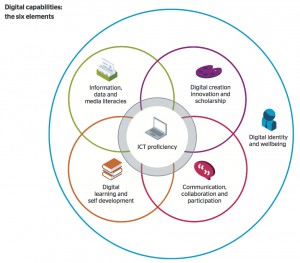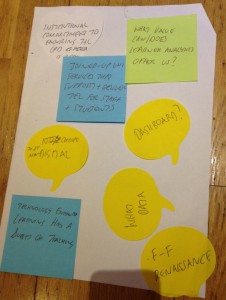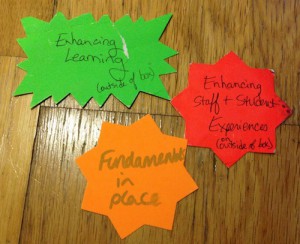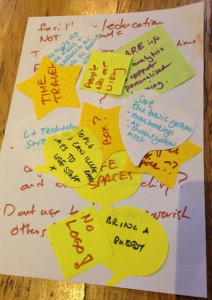This is a write-up of a workshop I ran for HEDG in November (yes finally! I have been working with universities in Australia since then – more in a following post). It is always good to work with educational developers, a group of people who are alive to the need for teaching staff to develop their digital confidence, and who are at the forefront of digital developments whether through curriculum initiatives, accredited courses for teaching staff, or one-off digital events. And of course educational developers are always open to being challenged, to reflecting deeply on current practice, and to playing with boxes and bits of coloured card 🙂
The workshop was a chance for me to learn more about the issues facing educational developers as universities become more digitally mainstream. Of course I also wanted to talk about the digital capabilities framework, and for us to consider ways in which it might be used in practice.
 In my presentation I reviewed some of the reasons for treating the digital revolution as a moment of discontinuous change for higher education, from the questions we address (and our methods of inquiry), through the content of the curriculum and the demands made of graduates in employment, to the expectations students have of their learning environment. I looked at the evolution of Jisc’s framework, with new features such as:
In my presentation I reviewed some of the reasons for treating the digital revolution as a moment of discontinuous change for higher education, from the questions we address (and our methods of inquiry), through the content of the curriculum and the demands made of graduates in employment, to the expectations students have of their learning environment. I looked at the evolution of Jisc’s framework, with new features such as:
- the inclusion of data literacy alongside information and media literacy as an essential way of understanding and engaging with knowledge;
- the expanded sense of innovation to include creative production and organisational/practice change alongside more conventional ideas of digital scholarship;
- the inclusion of digital wellbeing and the use of ‘digital identity’ to mean authentic practices of the self in digital spaces, rather than simply the projection of a positive persona;
- the ambition to make the framework applicable to a wide range of professional and academic staff (as well as researchers and students) in recognition of the role digital capability plays in all kinds of educational and para-educational practice.
After some discussion I asked each table to design a box. Inside each box was the framework plus other tools (their choice!) to help them to embed digital capability among teaching staff. On the outside of the box were words and phrases that would really encourage staff to pick up the box and look inside.
Before they could even use the box, HEDG members identified some issues that their institution needed to get right. These included:
- technology that is up to date, robust, and ‘just works’ at the times and in the spaces where it is needed;
- a commitment to professional development – especially the time and opportunity to try new practices with support, with colleagues, in a spirit of playfulness/curiosity/inquiry, and without judgement or fear of public failure;
- strategies for Technology and for Learning, Teaching and Assessment that are integrated and are followed through with resources, recognition and other necessary support;
- ‘the right people’, whether professionals, colleagues, or student champions/buddies, who are using digital technologies in practice, in contexts that are similar enough to make sense to new users, and who are available (can provide timely technical, pedagogical or moral support).
Given those institutional commitments, some of the things HEDG members wanted inside the box were these:
- ‘Imagined futures and cautionary tales’; ‘time travel’ or postcards from the future: compelling visions of a staff and student experience in which digital technologies are successfully integrated, along with stories of what can go wrong (or what can go differently/unexpectedly). Scenarios as tools for thinking with.
- Classic educational principles reframed for a digital age; or learning activities/tasks reframed with digital mediation; ensuring that new digital practices are underpinned with sound pedagogy and established ways of working.
- (Similarly) Digital approaches ‘mapped’ or ‘hooked’ into familiar teaching tasks such as curriculum design, learning support, assessment, marking, giving feedback, evaluation; emphasising what technology particularly enables and where face-to-face or print-based approaches are equally/more appropriate.
- (Example) Roadmaps for realising the imagined future in practice: described as a ‘backwards mapping’ of strategies.
- More on the difference between ‘transactional’ and ‘transformational’ approaches to the use of digital technologies in student learning.
- More evidence of the link between digital proficiency and learning/lifecourse outcomes, and between digital proficiency and excellent teaching (I think we’d all like this!)
- Examples of learner analytics in use: both practical tools such as dashboard services, and case studies or narratives of effective use to enhance learning/teaching/the student experience.
With so many good ideas to work on, it’s understandable that less thought went into the outside of the box or the ways in which these tools might be made attractive and relevant to staff. In fact, some participants said there was no need to ‘sell’ the contents if they did the right job. However, the consensus was that staff are most interested in innovations that:
- help them to work smarter, not harder
- help them to deal with student-related issues such as higher numbers, greater variety of backgrounds and prior experiences;
- genuinely and demonstrably enhance student learning;
- make the teaching/learning experience more interesting, exciting, engaging.
Overall this is probably the most helpful list of staff/educational development tools I have been able to draw up since I started work on this project, and I am grateful for the Heads of Educational Development for engaging so willingly (and playfully!) with the task. I really hope the coming year sees some of these tools being developed: look out for those boxes!





One reply on “Working with the Heads of Educational Development Group”
Love the box idea.
I’m tempted to adapt it to a few things I teach
Employability with inside being the skills/knowledge your have and outside being how you demonstrate it maybe
Or my tech-support course when trying to get learners to write good troubleshooting jobsheets with inside what makes a good jobsheet and outside how good jobsheets make you life easier
Would be a fun and active method.